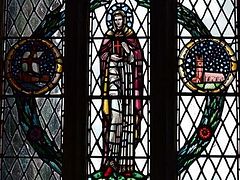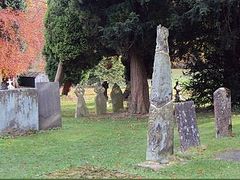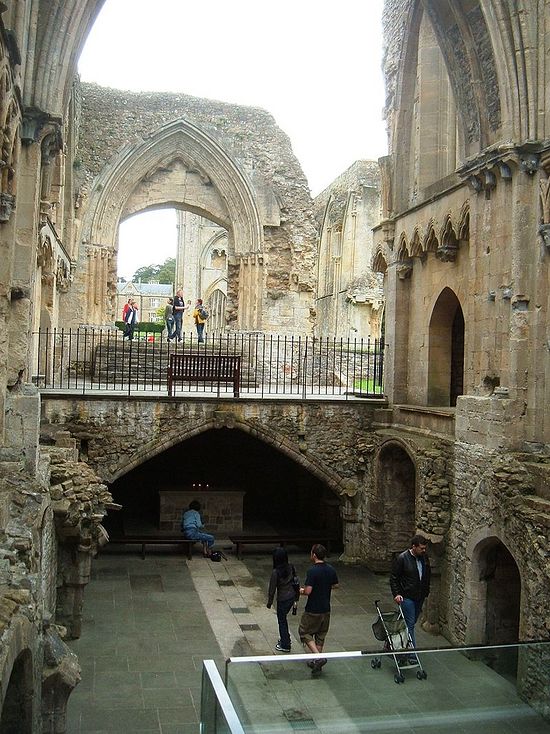 The Lady Chapel of the ruined Glastonbury Abbey, Somerset
The Lady Chapel of the ruined Glastonbury Abbey, Somerset
The town of Glastonbury, which has a population of about 9,000, is situated in Somerset in the south-west of England and lies twenty-three miles south of Bristol. This settlement has been inhabited for around 4,000 years. Scientists say that tribes of farmers settled in the area in the fifth millennium B.C. Originally, Glastonbury was an island, surrounded by lakes and marshes on all sides, and later called Avalon. The first Glastonbury inhabitants built primitive wooden structures and made simple tools and artefacts. In 1890 archeologists found ten ancient huts in the surroundings of Glastonbury.
Roman control of Britain which began in the first century A.D. is barely discernible here. The first English settlers, Saxons, called it “Glestingaburg”, probably meaning the enclosure of an Irish hermit of that name. The area was settled by “Sumor”, a group of Saxons, from the late sixth century on: hence the name of the county—Somerset. In some sense, there are two towns called “Glastonbury”. The first and physical one can be seen to this day: it is famous for its monastery, numerous saints who studied or lived here, and a host of relics. But there is also a second one, a mythical one, linked to Christ Himself, the Mother of God, Joseph of Arimathea, the Holy Grail and even King Arthur. This is legendary, but we will try to talk about this holy site from both perspectives, mentioning what is relevant to Christian spirituality.
In our days Glastonbury is home to an annual rock festival attracting thousands of fans, and also to the occult. The New Age, wizards and witches carry out rituals here. Supposedly “magic” items are sold and neo-pagans of all sorts are drawn here… With all of this, we shouldn’t forget that for almost 2,000 years of Christianity Glastonbury has been inspired by the Gospel of Christ and regarded as one of the holies places of England. It was nicknamed “the English Holy Land.”
The Monastery at Glastonbury and the veneration of the Theotokos
Glastonbury began to prosper after a monastery in honor of Jesus Christ and the Holy Virgin Mary was founded here[1] in about 703 by the right-believing King Ina (Ine) of Wessex. And it was not the first monastic settlement on this land. From ancient times this place was considered to be a site of veneration of the Mother of God. According to legends, long before King Ina, a church of the Holy Theotokos stood here and housed an ancient miracle-working icon of the Most Pure Virgin, created by St. Joseph of Arimathea at the command of an angel to show his great devotion to Her (it had been the first church and icon of the Mother of God in Britain!). It was called “the Glastonbury Icon of the Mother of God” (later, “Our Lady of Glastonbury” in the Roman Catholic tradition) and kept at the monastery till the late Middle Ages. The original miraculous church that had housed this unique relic had been built of wattle and daub (later replaced by a wooden building[2]). Pilgrims from all corners of Britain and other European countries flocked to Glastonbury. It was a rare example of such an early dedication of a shrine to the Mother of God in Western Europe.
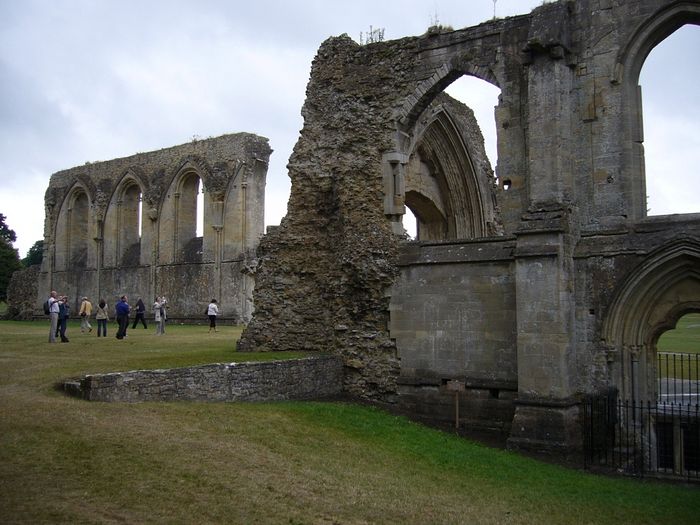 Glastonbury Abbey ruins, Somerset
Glastonbury Abbey ruins, Somerset
Anglo-Saxon and Norman kings provided generous endowments to the monastery. Royalty, nobility, scholars, merchants, landowners, peasants, shepherds, artisans, soldiers—everybody would come to Glastonbury to seek the help and intercession of the Queen of Heaven both in days of peace and of wars and disasters. The population grew, and the All-Holy Virgin helped everyone, sometimes appearing in visions. Later, in the Catholic period, a sculpture of the Mother of God was created at this monastery, which too was called “Our Lady of Glastonbury”. Glastonbury grew into one of the largest and wealthiest monastic centers of England, a home of monks, abbots, future bishops, scholars, historians; a center of learning, education, art and crafts; it had a huge library with countless unique early Christian books and documents and copies of unique histories of England (it was dispersed after the Reformation).
In 1184, there was a devastating fire in Glastonbury in which the main abbey church and the small church of the Mother of God were destroyed, though Her wonderworking statue survived. The monastery reconstruction began right away, under King Henry II and finished after his death in 1191. The Glastonbury statue of the Mother of God was placed in the new Lady Chapel. The culmination of the medieval pilgrimage was September 8 (according to the old calendar), the feast of the Nativity of the Theotokos, when the majority of pilgrims would come and a fair was held in the town.
The veneration of Glastonbury as a holy site continued till the sixteenth century when this monastery was destroyed during the Reformation. In 1539, on the orders of Henry VIII the abbey was dissolved, and the innocent seventy-eight year-old Abbot Richard Whiting hanged and quartered on November 15 of that year. Four other monks were executed with him. The generally loved and venerated sculpture of “Our Lady of Glastonbury” disappeared for good.
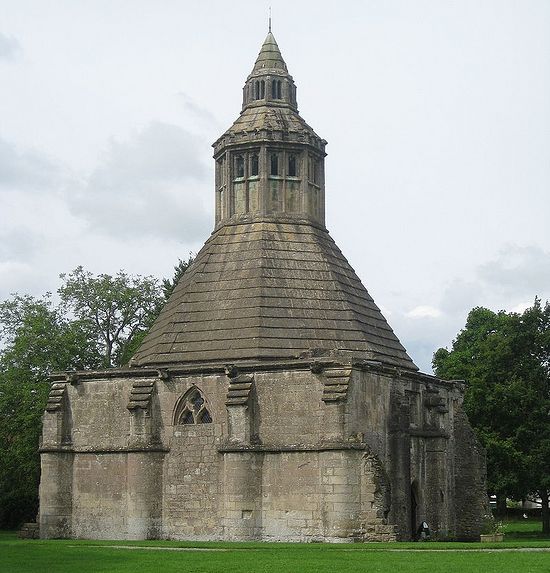 The former abbot's kitchen amid the abbey ruins in Glastonbury, Somerset
The former abbot's kitchen amid the abbey ruins in Glastonbury, Somerset
Only ruins remain from the once huge monastery in Glastonbury. Though some monastic buildings partially survive or stand to their full height, notably the fourteenth-century abbot’s kitchen which is ranked among the most splendid in Europe. The best preserved ruin is the medieval Lady Chapel, on the territory of which there is the ancient holy well of St. Joseph of Arimathea, which appeared in the Roman period. Set in beautiful parkland (thirty-six acres), these ruins, which are about 900 years old, give a striking impression of the holiness, importance and power that they had in the Middle Ages. But even after the desecration and destruction of Glastonbury’s unique shrines its magnificent ruins (the main abbey church alone was over 220 feet long and forty-five feet wide) still gloriously rise above the green meadows of Somerset, reminding everyone that this holy place was chosen by God and the Holy Theotokos. The abbey ruins and the well belong to the Church of England (according to “Britain’s Holiest Places”) and there is a museum attached to them which tells the story of the monastery. Since 2019 there has been a small Catholic Benedictine monastery in honor of Our Lady of Glastonbury in the town. Its main shrine is the new statue of Our Lady of Glastonbury.
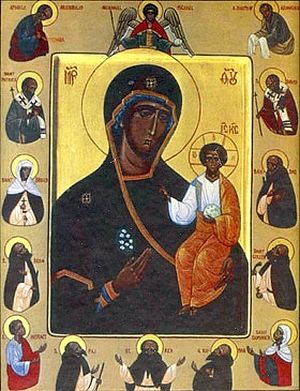 The Glastonbury icon of the Mother of God In the early twentieth century the restoration of this holy site began. In 1939, 400 years after the barbarous destruction by the “Reformers”, the construction of a new Catholic Church of the Mother of God in Glastonbury commenced, and in 1955 the new and long-awaited statue of the Favorite and Protectress of England, and of Glastonbury in particular—the “Mother of God of Glastonbury”—was completed and placed inside this church. In the 1980s, Archimandrite Mark (Meyrick) of the Russian Orthodox Church Outside Russia, painted the Orthodox icon of the Mother of God of Glastonbury which is of the Hodigitria type (however, this icon is still venerated only unofficially). The Queen of Heaven showed Her mercy, and Her veneration here was revived.
The Glastonbury icon of the Mother of God In the early twentieth century the restoration of this holy site began. In 1939, 400 years after the barbarous destruction by the “Reformers”, the construction of a new Catholic Church of the Mother of God in Glastonbury commenced, and in 1955 the new and long-awaited statue of the Favorite and Protectress of England, and of Glastonbury in particular—the “Mother of God of Glastonbury”—was completed and placed inside this church. In the 1980s, Archimandrite Mark (Meyrick) of the Russian Orthodox Church Outside Russia, painted the Orthodox icon of the Mother of God of Glastonbury which is of the Hodigitria type (however, this icon is still venerated only unofficially). The Queen of Heaven showed Her mercy, and Her veneration here was revived.
There is currently no permanent Orthodox presence in Glastonbury, but annual pilgrimages of Orthodox, Catholics and Anglicans are arranged to this site; Christian services (including an Orthodox service once a year) take place; prayer services are conducted and processions with the statue and the holy image of “Our Lady of Glastonbury” are held. Anglican and Orthodox groups arrange pilgrimages in June and Catholics in July. Services are normally held in St. Patrick’s Chapel, and Orthodox worship on the territory of the Lady Chapel and venerate the Glastonbury Icon. Glastonbury is regarded among some Orthodox as “the English Jerusalem” and loved on a par with Lindisfarne (“the English Mt. Athos”), Walsingham (“the English Nazareth”). The monastery ruins are visited by 100,000 pilgrims from all over the world per year, according to the Abbey’s website.
Over the centuries Glastonbury has been renowned for its numerous saints. Let us recall some of them.
Righteous Joseph of Arimathea and the miraculous Glastonbury thorn
 An icon of St. Joseph of Arimathea by J Cole (taken from the website of the All-Merciful Savior's Church, Austin, Texas) According to late legends, the Righteous Joseph of Arimathea (feasts: April 9/22 and July 31/August 13) chose what is now southwestern England as the center of his preaching. A noble and rich Sanhedrin member from the town of Arimathea (Ramalla), he was a secret disciple of Jesus Christ. All four Gospels mention him. He did not take part in the Sanhedrin trial at which the Jews condemned the Savior to death. After the Crucifixion and death of the Lord St. Joseph dared to approach Pontius Pilate and assumed responsibility for burying His body. Together with St. Nicodemus, the Mother of God and the Myrrh-bearing Women he took down Christ’s Body from the Cross, wrapped It into the shroud and laid into a tomb cut out of the rock that he (Joseph) had previously prepared for himself. Having leaned a heavy stone against the wall, they left.
An icon of St. Joseph of Arimathea by J Cole (taken from the website of the All-Merciful Savior's Church, Austin, Texas) According to late legends, the Righteous Joseph of Arimathea (feasts: April 9/22 and July 31/August 13) chose what is now southwestern England as the center of his preaching. A noble and rich Sanhedrin member from the town of Arimathea (Ramalla), he was a secret disciple of Jesus Christ. All four Gospels mention him. He did not take part in the Sanhedrin trial at which the Jews condemned the Savior to death. After the Crucifixion and death of the Lord St. Joseph dared to approach Pontius Pilate and assumed responsibility for burying His body. Together with St. Nicodemus, the Mother of God and the Myrrh-bearing Women he took down Christ’s Body from the Cross, wrapped It into the shroud and laid into a tomb cut out of the rock that he (Joseph) had previously prepared for himself. Having leaned a heavy stone against the wall, they left.
There are a number of very late legends associated with his link to England. Let us relate some of them. Firstly, St. Joseph together with Sts. Martha, Mary and Lazarus are said to have travelled to Gaul as missionaries. Leaving his companions on the continent, Joseph travelled further—to Britain. On arriving in Britain he built a church dedicated to the Mother of God in Glastonbury. (In this case it was the first church of the Theotokos in the world. It was destroyed by fire in 1184). As soon as he started preaching the glad tidings of Christ, the locals tried to oppose him, screaming and pelting stones at him. The saint was not scared and, strengthened by the grace of God, carried on his preaching.
One day, on the feast of Nativity, St. Joseph was standing on Wearyall Hill (now on the west side of the town) and telling the pagans about the Birth of the Savior of the world in the manger. The indignant crowd refused to believe and demanded miracles. St. Joseph who always took a walking stick with him heard a voice commanding him to thrust it into the ground. The righteous man obeyed, and, lo and behold, the stick suddenly took root, leafed out, and blossomed[3]. Seeing the great sign, the people came to believe in Christ. This plant began to grow and stood on that spot for many centuries, cherished first by monks. It has been known as the Glastonbury Holy Thorn ever since, and according to botanists it is a variety of the common hawthorn, whose origins are in the Middle East, but which now can be found throughout Europe. The Glastonbury Thorn does not reproduce from cuttings, but by being grafted onto a related plant. It does not fruit, but, unlike other common hawthorns, it flowers twice a year: on the Nativity according to the Julian calendar and in spring (often coinciding with Orthodox Pascha). Each year since 1929 a budded sprig has been presented to the ruling monarch (now Queen Elizabeth II).The monarch places the sprig on the dinner table on Christmas Day.
This tradition seems to be older because as early as the seventeenth century a spray was sent to the Queen Consort Anne (1574—1619), the wife of King James I. The Glastonbury thorn has been considered miracle-working through its history, even well after the Reformation, when the veneration of holy objects was prohibited. In September 1752, England adopted the revised calendar of Pope Gregory XIII. On the next feast of the Nativity of Christ a large concourse of people observed that the thorn bloomed the same day as before: eleven days later than the new Nativity date. In 1653, a Puritan soldier chopped down the original Glastonbury Thorn (and was immediately blinded, so it is said), but local inhabitants had earlier taken its cuttings and later replanted them around the town, and several new trees, its “descendants”, began to grow there. The contemporary Glastonbury icon, apart from the saints associated with this place, depicts the Mother of God holding a branch of the Glastonbury Thorn.
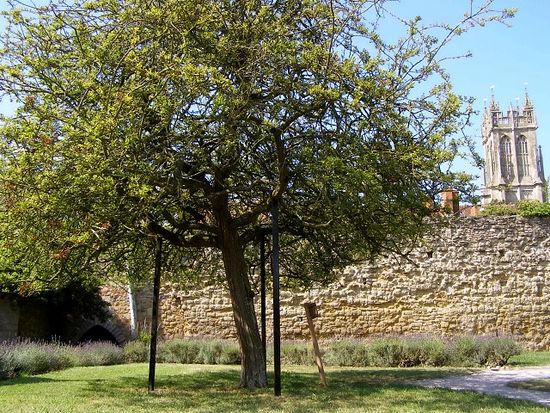 One of the surviving Glastonbury thorns, Somerset (source - Geograph.org.uk)
One of the surviving Glastonbury thorns, Somerset (source - Geograph.org.uk)
On December 8, 2010, unidentified vandals chopped down a thorn that had stood on a slope of Wearyall Hill where St. Joseph had preached and had been linked to him; as a result only a part of its bare trunk remained, which was removed in 2019. However, a few other thorns still stand elsewhere within Glastonbury—descendants of that wonderworking tree of St. Joseph. One can be found in the Abbey Grounds, others—at the Somerset Rural Life Museum, the Chalice Well Gardens, in the churchyard of the fifteenth-century St. John the Baptist Church[4] (two trees), and in other places.[5]
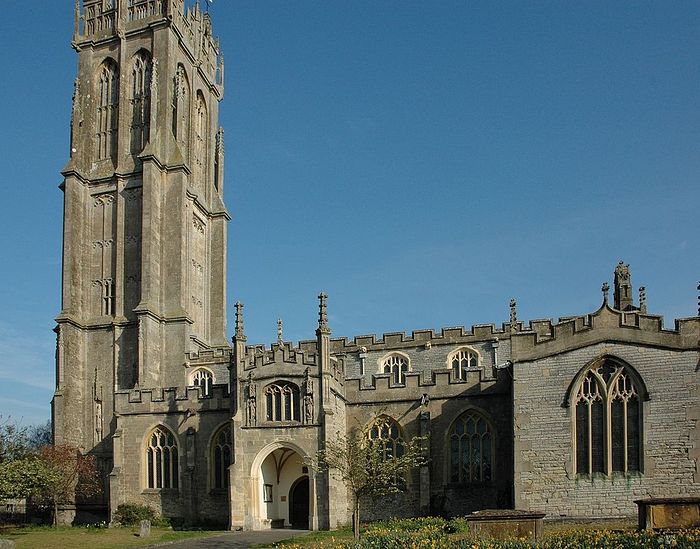 St. John the Baptist's Church in Glastonbury, Somerset
St. John the Baptist's Church in Glastonbury, Somerset
A second legend, untrustworthy but still symbolic, says that St. Joseph was a rich merchant in Jerusalem and its surroundings. He was an uncle of the Virgin Mary: he came to Nazareth where he remained with the Mother of God and Jesus Who was about fourteen. St. Joseph came to love the Divine Child and after the demise of St. Joseph the Betrothed, he asked Mary to allow him to take Her Son on one of his voyages abroad. She received Jesus’ consent and allowed him to do it. Their ship sailed through the Mediterranean, stopping at various ports for trade. Having crossed the Atlantic, their ship moored on the coast of Cornwall. The ship was full of peculiar commodities that they hoped to exchange for the region’s famous tin. Britain did have trading links with the Roman Empire and it came to be fully conquered by the Romans in 43 A.D. The travelers made for Glastonbury, which was a well-known port and a trading place. The merchants may have visited other trading sites of Britain further inland, while riding on donkeys, and taking Jesus Christ with them.
True, that is just a late legend and we should take it symbolically, spiritually rather than literally. However, there are a number of recent settlements and place names not far from Glastonbury with the words “God”, “Jesus”, and “Paradise” in them (Paradise Farm, Paradise Lane, Paradise House, Godney, Christon, etc.), indirectly indicating that local residents believed in the legend. There is the hamlet of Priddy at the top of the Mendip Hills close to Glastonbury; it is noted for this curious, though recent, saying: “As sure as our Lord was at Priddy.” A similar saying concerns the neighboring region of Gloucestershire. The unofficial national anthem of England, commonly known as “Jerusalem”, is based on the poem by William Blake (1757—1827), “And Did Those Feet in Ancient Time”, and set to music by the composer Hubert Parry (1848—1918) in 1916. The words are based on this legend about the visit of Christ to Britain:
And did those feet in ancient time,
Walk upon England’s mountains green:
And was the holy Lamb of God,
On England’s pleasant pastures seen?
And did the Countenance Divine,
Shine forth upon our clouded hills?
And was Jerusalem builded here,
Among these dark Satanic Mills?
Bring me my bow of burning gold:
Bring me my Arrows of desire:
Bring me my Spear: O clouds unfold:
Bring me my chariot of fire!
I will not cease from Mental Fight,
Nor shall my Sword sleep in my hand:
Till we have built Jerusalem,
In England’s green and pleasant land.
Even if Christ’s feet never stepped on England, He did live in the hearts of a host of saints who blessed this land with their prayers and whose spirit reigns here and there to this day, as if they still dwell there. The legends have inspired many cultural figures over the centuries. Among them let us mention the modern folk rock band Blackmore’s Night: this theme is reflected in their songs “Avalon” and “Wind in the Willows.”
Thirdly, another legend claims that after the Resurrection of our Lord the chief priests flew into a rage at St. Joseph because he had arranged the deposition of Christ from the cross and His burial in his new tomb. They wanted to kill him but dared not because he was a man of great importance in Jerusalem. They put him on a ship and let it drift out to sea. That small vessel with the help of God sailed through the Atlantic and reached the shores of Britain. Thus St. Joseph came to the port on the site of Glastonbury. Soon he preached Christ to a local nobleman. Though the man listened to his story willingly, he could not make up his mind whether to embrace Christianity or not.
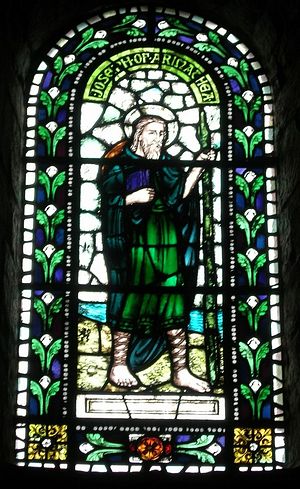 St. Joseph of Arimathea depicted on stained glass at St. Magnus's Cathedral, Kirkwall, Orkney (kindly provided by Dr. Avril Lumley Prior) On the eve of the Nativity he said that he would not believe in the Savior if his (Joseph’s) staff did not blossom and leaf out next day, in the middle of winter. Joseph spent the whole night in prayer, asking God to convert the heart of the noble pagan. The next morning, when the earth was covered with snow, there stood a blooming hawthorn bush near his (the pagan’s) house. St. Joseph had the nobleman and his assistants baptized and together they built a little church where the first services were held. Legend has it that Joseph had twelve disciples, bishops or priests among them, who celebrated services. According to tradition, St. Joseph of Arimathea reposed peacefully in Glastonbury and was buried there. Not long before the monastery’s closure St. Joseph’s Chapel was built below the Lady Chapel.
St. Joseph of Arimathea depicted on stained glass at St. Magnus's Cathedral, Kirkwall, Orkney (kindly provided by Dr. Avril Lumley Prior) On the eve of the Nativity he said that he would not believe in the Savior if his (Joseph’s) staff did not blossom and leaf out next day, in the middle of winter. Joseph spent the whole night in prayer, asking God to convert the heart of the noble pagan. The next morning, when the earth was covered with snow, there stood a blooming hawthorn bush near his (the pagan’s) house. St. Joseph had the nobleman and his assistants baptized and together they built a little church where the first services were held. Legend has it that Joseph had twelve disciples, bishops or priests among them, who celebrated services. According to tradition, St. Joseph of Arimathea reposed peacefully in Glastonbury and was buried there. Not long before the monastery’s closure St. Joseph’s Chapel was built below the Lady Chapel.
Here is an extract from an interesting document, published in Glastonbury in the eighteenth or early nineteenth century:
“Being returned from home, and having given a full account to the apostles, of what that special service he had done for the vindication for the Christian family at Rome, he (St. Joseph) was appointed and ordained to go and preach the Gospel in England; and according to the mission commanded to him, he took shipping to Joppa, and sailing with a great deal of difficulty, and meeting dangerous storms, through the Mediterranean Sea, he landed at Barrow Bay in Somersetshire, and then proceeding on his journey eleven miles that day, came to Glastonbury in the same county; where, fixing his pilgrim’s staff in the ground, it was no sooner set in the earth but just like Aaron’s rod it was turned into a blossoming thorn, which supernatural miracle made the numerous spectators, who came to see this wonder, be very attentive to hear his preaching the Gospel, which was concerning Christ crucified for the redemption of mankind.
“He arrived at Glastonbury about three years after the death of our Redeemer, doing such wonderful miracles, that he brought to the conversion of Christ above one thousand souls. Besides, as Eusebius and Ruffinus, most faithful ecclesiastical writers, relate, he baptized at the city of Wells, within six miles of Glastonbury, eight thousand one day; so devout, zealous, and holy was the life of Joseph, that although he found the inhabitants of this island barbarous and superstitious, yet by wholesome admonitions, in a learnedly and strenuously exhorting them to change their erroneous opinions, representing before their eyes, the heinousness of heir folly and blindness, he persuaded them to hazard the salvation of their souls, and their posterity, by abandoning downright idolatry, in worshipping the sun, moon, and stars, living creatures, both on the earth and in the sea.
“Joseph, by his godly life and good behavior, having obtained the good-will of Ethelbertus, a king, then reigning in the western parts of England, and many other nobles, whom he converted to the Christian faith, he founded a most famous abbey at Glastonbury, it became one of the richest monasteries in Christendom.
“In the ancient town of Glastonbury, the holy Joseph of Arithamea continued until the day of his death, being forty-two years, so that he was eighty six at his death; so venerable was his person that the kings of those parts honored the corpse by them carrying on royal shoulders to the grave; which was made in the chancel of Glastonbury Abbey and had a most stately tomb erected over him.
“And in veneration of Joseph, a lady living in Glastonbury a little after the death of this holy man, obtained of her husband as much pasture around for the good of the inhabitants, as she was able to walk about barefoot in a whole day.
“But what is more remarkable is the White Thorn called the Holy Thorn which to this very time is noted through all Europe for its budding on Christmas. Although the time of superstitious popery is in this kingdom abolished, thousands of people of different opinions, go annually to see this curiosity, which appearing supernatural, and contrary to the course of nature makes us cry out with the Psalmist, ‘Oh Lord how marvelous are Thy ways.’”
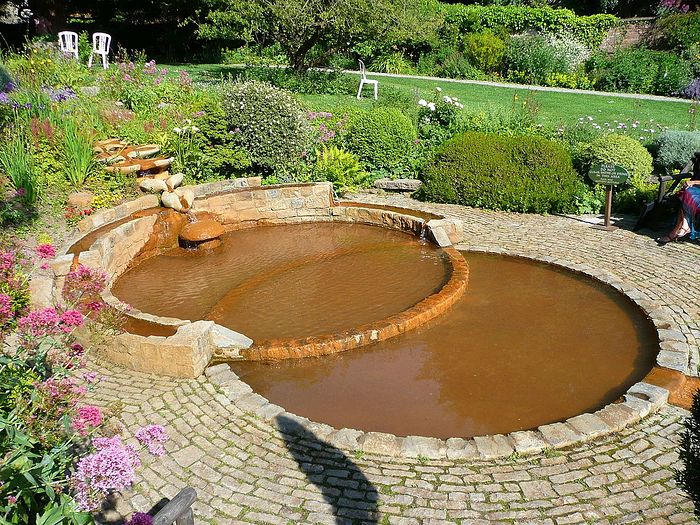 The Chalice Well in Glastonbury, Somerset
The Chalice Well in Glastonbury, Somerset
There are many other legends, many even more unlikely. According to one of them, St. Joseph brought the Holy Grail to Glastonbury. It was allegedly the chalice (holy cup) preserved from the Last Supper of Christ. In memory of this legend—and to attract tourists—relatively recently people established on the east side of the town the Chalice Well Gardens, with the Chalice Well (also known as the Red Spring and the Blood Spring), covered with a well cover, in them. Red stains are left by the spring’s running water on account of the iron in the water. Legend has it that St. Joseph buried the Holy Grail with some of the Savior’s Blood on that spot which accounted for this phenomenon. According to scientists, the red color of the spring is nothing but rust because of the high content of iron in the water. This well never dries up, even during droughts. According to Nick Mahew Smith, this well fills up a basin by the entrance to the garden and is occasionally used for bathing. The garden is cared for by a trust which promotes friendly relations between different denominations; its official name is the World Peace Garden.
There are other beautiful yet untrustworthy legends, one of which claims that in the late twelfth century the graves of King Arthur (who with his knights had allegedly come to Glastonbury in search of the hidden Holy Grail) and his wife Guinevere were discovered at Glastonbury Abbey by its monks! This much contributed to the monastery’s popularity and wealth as the naïve wanted to visit the grave of a half-legendary hero.
We deem it necessary to mention another historical figure connected with Glastonbury: this is William of Malmesbury († c. 1143), who is considered by many as the foremost English medieval historian. William stayed at Glastonbury Monastery for some time and wrote his famous work, On the Antiquity of Glastonbury Church, from which we derive many interesting details; in it he does not mention any link with King Arthur or the Holy Grail whatsoever. In another famous work of his, The Deeds of the English Kings (who spanned from 449 A.D. till 1127), William does mention that some immediate disciples of Christ enlightened Britain. Glastonbury Monastery produced many such figures, among them Monk John of Glastonbury, a chronicler who in the first half of the fourteenth century wrote The Chronicles of the Antiquities of the Glastonbury Church. It was John who wrote that St. Joseph of Arimathea came to preach in England and brought some of the blood and sweat of Christ with him. However, both William and John are criticized by some modern historians as myth-makers.
Other saints associated with Glastonbury
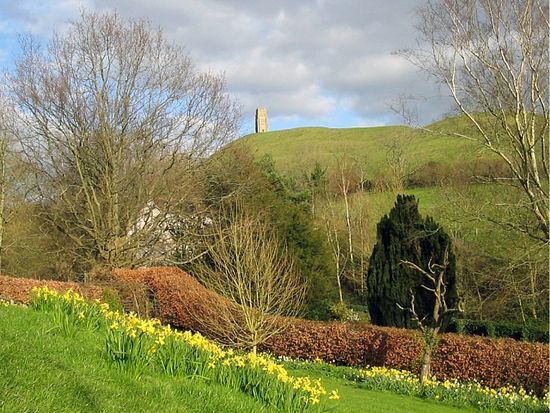 Glastonbury Tor, Somerset (source - Geograph.org.uk)
Glastonbury Tor, Somerset (source - Geograph.org.uk)
The Archangel Michael has been venerated in Glastonbury from ancient times. There is a high and steep hill called Glastonbury Tor near the town, which rises from the lowlands and looms over the northern part of Somerset. It is another important holy site and is said to be the heart of the original island of Avalon (its name means, “the island of apples”, or, “the island of Paradise”). In fact it is situated on a peninsula. A very early church of Archangel Michael used to stand on its top, though only its fourteenth-century roofless tower survives as it was first destroyed by an earthquake on September 11, 1275, and the replacement church was pulled down during the Reformation. Pilgrims coming to Glastonbury try to visit all the holy sites concentrated around the town and its surroundings, and climb Glastonbury Tor (520 feet tall) and say a prayer to Archangel Michael. Views of the Quantocks, the Mendips, the city of Wells and sometimes the Welsh mountains open from its summit.
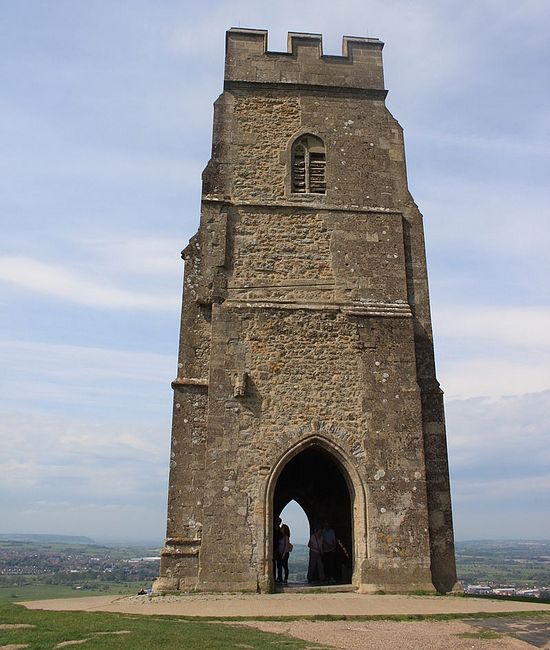 The tower of St. Michael's Church on top of Glastonbury Tor, Somerset
The tower of St. Michael's Church on top of Glastonbury Tor, Somerset
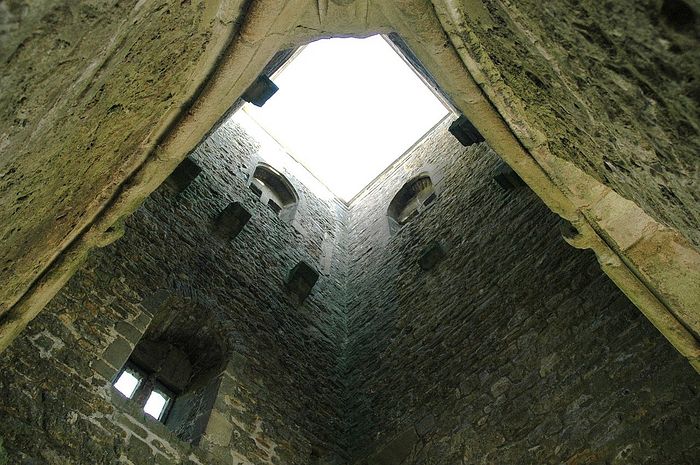 Interior of the tower of St. Michael's Church on Tor, Glastonbury, Somerset
Interior of the tower of St. Michael's Church on Tor, Glastonbury, Somerset
Excavations on the Tor in the mid-1960s revealed the supposed remains of a monks' cell, cut into the rock beneath the summit in the sixth century. There was probably a group of hermits on the top of Glastonbury Tor in the Irish and perhaps in the later period. The veneration of Archangel Michael is typical for elevated places and islands. He is revered as the one who vanquished satan (the ancient dragon) and converted former pagan places of worship into places of Christian worship (druids performed their rituals there before the Tor had been blessed by Christian prayer). Among other examples of note let us recall Skellig Michael in Ireland, St. Michael’s Mount in Cornwall, Mont-Saint-Michel in Normandy, and Monte Gargano (with the Sanctuary of Monte Sant’Angelo) in Italy.
Among other saints connected with Glastonbury let us mention:
St. Aidan of Lindisfarne, a great Irish missionary and the enlightener of Northumbria (†651; feast: August 31). His relics were moved from Lindisfarne to Glastonbury in the tenth century;
The Holy Archbishops Athelm (+ 926; feast: January 8) and Brithwald (+731; feast: January 9) of Canterbury lived in Glastonbury as monks and later probably served as its abbots, before becoming archpastors;
Sts. Brigid of Kildare, Patrick of Ireland, and David of Wales, according to various traditions, may have visited Glastonbury. St. Brigid may have led an ascetic life here for some time, and in memory of her labors two ancient churches are dedicated to her on the Somerset coast, in the villages of Brean and Chelvey. St. Patrick was said to organize a cell of hermits in Glastonbury, and a portion of his relics was translated here some time after his death. In the later period of the monastery the abbey almshouses in honor of St. Patrick were built and St. Patrick’s Chapel erected in 1500. St. David may have founded the earliest monastery in this town and endowed it with a jewel that he had brought from the Holy Land;
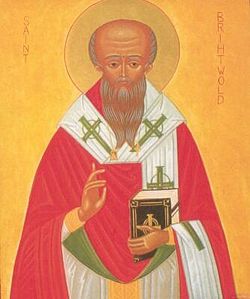 An icon of St. Brithwald of Ramsbury Another holy hierarch with the name Brithwald († c. 1045; feast: January 22) in his young days lived in Glastonbury as a monk, and in 1005 was consecrated Bishop of Ramsbury in Wiltshire. He later moved his see to Old Sarum near Salisbury. St. Brithwald was a great benefactor of Glastonbury Monastery where he was buried. He had the gift of prophecy and had miraculous visions;
An icon of St. Brithwald of Ramsbury Another holy hierarch with the name Brithwald († c. 1045; feast: January 22) in his young days lived in Glastonbury as a monk, and in 1005 was consecrated Bishop of Ramsbury in Wiltshire. He later moved his see to Old Sarum near Salisbury. St. Brithwald was a great benefactor of Glastonbury Monastery where he was buried. He had the gift of prophecy and had miraculous visions;
The holy Celtic monks St. Collen (feast: May 21), St. Kea (feast: November 5), and St. Rumon (feast: August 30) may have visited the area of Glastonbury as missionaries and preachers;
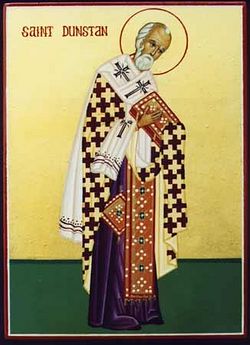 An icon of St. Dunstan of Canterbury The archpastor Dunstan of Canterbury (+ 988; feast: May 19) led an ascetic life in Glastonbury for many years, becoming its abbot in 940. It was from Glastonbury that the spiritual and monastic revival of England began in the tenth century. A portion of St. Dunstan’s relics was kept at Glastonbury, which he loved and protected, for a long time. Thanks to this illustrious hierarch, Glastonbury later became one of the most powerful monasteries in Western Europe, enjoyed royal patronage and was the richest monastery in the country after Westminster Abbey;
An icon of St. Dunstan of Canterbury The archpastor Dunstan of Canterbury (+ 988; feast: May 19) led an ascetic life in Glastonbury for many years, becoming its abbot in 940. It was from Glastonbury that the spiritual and monastic revival of England began in the tenth century. A portion of St. Dunstan’s relics was kept at Glastonbury, which he loved and protected, for a long time. Thanks to this illustrious hierarch, Glastonbury later became one of the most powerful monasteries in Western Europe, enjoyed royal patronage and was the richest monastery in the country after Westminster Abbey;
St. Eanfleda († c. 704; feast: November 24), the saintly daughter of King Edwin of Northumbria who later became Queen, the mother of another saint, and successor of St. Hilda as Abbess of Whitby. In the tenth century her relics were brought to Glastonbury together with St. Hilda’s;
The holy righteous King Edgar the Peaceful († 975; feast: July 8), who in effect was the first King of the English, was buried in Glastonbury after his death in Winchester. St. Edgar was a great supporter of the Church, monks and hierarch, promoting the spread of monastic life during the tenth-century spiritual revival of England. Many people, royalty included, sought to be buried at such holy sites as Glastonbury. Among those buried at this monastery were King Edmund I (+967) and King Edmund Ironside (†1016). No trace of their tombs survive because all that could be destroyed was destroyed during the Dissolution. In the later period of the monastery one of its chapels was dedicated to Edgar;
The English princess Elfleda (+ 936; feast: October 23), who lived as an anchoress in Glastonbury for many years, renowned for her gift of prayer. She influenced the young St. Dunstan of Canterbury;
St. Ethelnoth, the future Archbishop of Canterbury (+ 1038; feast: October 30) struggled in Glastonbury before his promotion to the archbishop’s see in 1020. Noted for his wisdom, he was called “Ethelnoth the Good”;
St. Ethelwold († 984; feast: August 1), one of the three restorers of the English Church in the tenth century, lived as a monk in Glastonbury under St. Dunstan before becoming Abbot of Abingdon and Bishop of Winchester;
St. Gildas the Wise († c. 570; feast: January 29), a celebrated Welsh missionary, historian and then preacher in Brittany, wrote that in his time Glastonbury Monastery was a prominent center of monastic life. Before moving to Brittany, St. Gildas had labored in Glastonbury for some time, and afterwards a small portion of his relics rested there;
The great Abbess St. Hilda († 680; feast: November 17) of Whitby, whose relics were found in the tenth century and a portion of them was moved to Glastonbury to save it from Danish pirates since the northeast was especially vulnerable to them;
The holy King Ina of Wessex and his wife Queen Ethelburga (both commemorated on September 8). St. Ina was King of Wessex between 688 and 726, after which he abdicated and went with Ethelburga to Rome where he ended his days as a monk; St. Ina is best remembered as the ruler who refounded and endowed Glastonbury Monastery with extensive lands. By 712, St. Ina had the monastery rebuilt, though the old church remained; and the charter signed by St. Ina said that it was “the first Christian church in the British land and the fountain of all faith in the kingdom”;
The holy Irish missionary Indract, his sister Dominica (Drusa) and their companions († c. 710; feast: February 5) were murdered by a pagan near Glastonbury on their way back from a pilgrimage to Rome, and their relics were enshrined at Glastonbury Monastery and kept there for a long time;
St. Neot (late ninth century; feast: July 31), a much-venerated hermit in Cornwall, in his youth served at Glastonbury Monastery. There is a famous story associated with the holy King Alfred the Great of Wessex (feast: October 26) and this saint. Before his decisive battle with the invading Vikings St. Alfred visited Glastonbury, venerated the shrine of the Holy Theotokos and asked for St. Neot’s blessing—St. Neot prayed for the king and predicted an overwhelming victory for him. In the poem The Ballad of the White Horse by G.K. Chesterton we read that the Mother of God appeared to St. Alfred and consoled him, when he had been driven to the river isle of Athelney in Somerset by the Vikings who had almost conquered the kingdom, and with Her help he defeated them at the Battle of Ethandun;
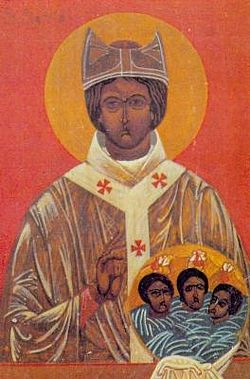 An icon of St. Sigfrid, the Apostle of Sweden (by Vitaly Koissin) The holy hierarch Sigfrid, the English-born Apostle of Sweden (feast: February 15), who enlightened many regions of that country, serving as bishop of Växjö, converting King Olaf and receiving the crown of the martyrs in the 1040s, had probably lived and studied in Glastonbury before leaving England, though the latter is disputed by some modern scholars.
An icon of St. Sigfrid, the Apostle of Sweden (by Vitaly Koissin) The holy hierarch Sigfrid, the English-born Apostle of Sweden (feast: February 15), who enlightened many regions of that country, serving as bishop of Växjö, converting King Olaf and receiving the crown of the martyrs in the 1040s, had probably lived and studied in Glastonbury before leaving England, though the latter is disputed by some modern scholars.
In conclusion let us say that since the Middle Ages Glastonbury has been a pilgrimage center and the town still has several late medieval buildings associated with hospitality to pilgrims. The George and Pilgrim’s Hotel in the center of the town dates back to the fifteenth century. Further, the Jacobi cottage in ancient times was a chapel dedicated to St. James (a patron of pilgrims), also known as the “Slipper Chapel”. Formerly it was the final stopping place for pilgrims travelling via Wells to Glastonbury. Pilgrims would take their shoes off here, wash their feet in the waters of a spring that flowed through the chapel and proceed to the monastery barefoot. A similar practice existed in other great monasteries and convents that contained famous shrines.
Hundreds of feet uphill stands a building called the Light Ship. In the late Middle Ages it was used as a hospice for pilgrims travelling from Wells. There are two fireplaces—a larger and a smaller one—surviving in this house: meat was generously roasted on them for hungry pilgrims who flocked in large numbers (the source for the information on these houses: Sister Elizabeth Rees, An Essential Guide to Celtic Sites and Their Saints, Burns and Oates, A Continuum Imprint London--New York, 2003).
Most Holy Lady Theotokos Who shone forth in the town of Glastonbury by Thy wondrous icon and miracles, save us!
All the Saints of Glastonbury and Archangel Michael, pray to God for us!

